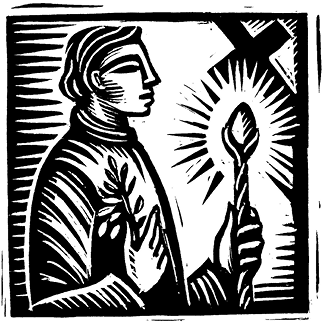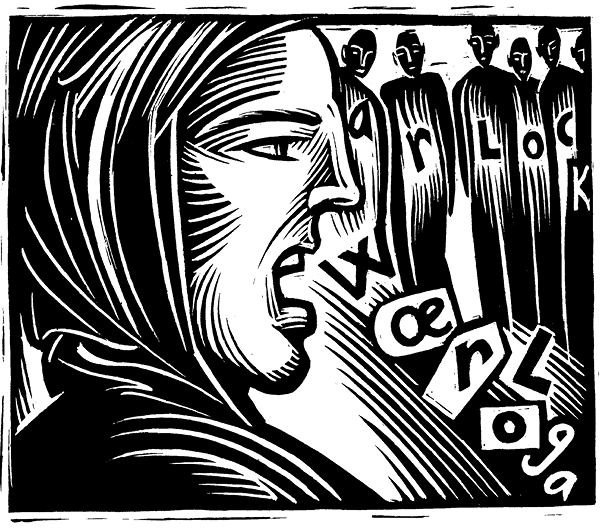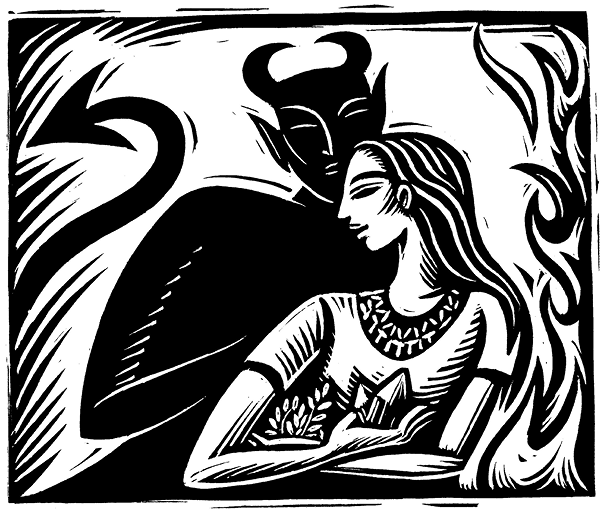Exonerating the Warlock:
A Brief History & Revisioning of a Misunderstood Term
Storm Faerywolf
T o those who are outside the Neo-Pagan movement, I am usually labeled a Warlock. As a man who is also a practitioner of Witchcraft, I don’t find this surprising, since English dictionaries are fairly unanimous in defining this word as “a male witch or sorcerer,” and have done so for half a millennia. Numerous works of poetry and literature spanning hundreds of years have used the term in this manner. It’s only when you move inside the Neo-Pagan bubble that this word suddenly becomes problematic.
To some modern practitioners, Warlock is thought of as an insult. Early Neo-Pagan writers—likely in an effort to promote the idea that they were in possession of a special type of insider knowledge—asserted that since Warlock derived from an older word with an arguably negative meaning, the term was rarely if ever used by actual Witches. While their observations of the word’s origins were correct, they failed to take into consideration the cultural context of those origins, or even basic rules of language.
Let me take this moment to proudly affirm: I am a Warlock. Though attitudes are slowly changing, when I’m addressing an audience of other Witches and Pagan folk, this revelation is often met with judgment and even disdain.
Let me take this moment to proudly affirm: I am a Warlock. Though attitudes are slowly changing, when I’m addressing an audience of other Witches and Pagan folk, this revelation is often met with judgment and even disdain. Even you, dear reader, may have already formed an opinion about who I am or what I do based on my decision to self-identify with this term. Believe me when I say I have probably heard it all: “Warlock means ‘oath breaker.’ You obviously don’t know what you are doing.” “Warlocks are those who have betrayed their coven! Why would you use that term?” “You must be new to the Craft. No experienced or self-respecting Witch would use that word.”
Though such people are grossly misinformed, I can’t exactly blame them. This is because early practitioners of the modern Craft, either mistakenly or deliberately, misrepresented the term. While warlock does likely derive from an older word that originally meant “one that breaks faith,” 1 its Christian-era origin must be taken into account when considering this application. Before the year 900 CE, the Old English wǣrloga (from which the modern Scottish warlock derives) was used to mean someone who had broken his baptismal covenant. 2 During the forced Christianization of Western Europe, country folk were often made to swear allegiance to the new Church, which included renouncing their previous religious observances. Men who continued to practice what was then considered by the Church to be heresy were sometimes branded “warlocks.” In other words, the word was used to describe men whom today we might identify as Pagan (another term with an older, originally negative meaning that has been reclaimed in recent times).

Though scholars accept the “male Witch” definition of Warlock as being correct, some Neo-Pagan circles have dug in their heels and have even expanded upon the original meaning, asserting that it really means “a Witch who betrays their coven.” There is, however, no historical evidence of this usage prior to the 1950s, meaning that the origin of this folk belief is a modern reinterpretation, and one that was (again, either deliberately or mistakenly) used to promote those in the Pagan movement as having special knowledge of the subject—knowledge that, upon further examination, evaporates into thin air. And yet, even in the face of these facts, the problem persists.

The misconception of the meaning of the word warlock is a prime example of the etymological fallacy, 3 which is when a word’s previous definition or root (an etymon) is incorrectly assumed to be that word’s “true” meaning without regard to how words evolve and change definition over time (aka semantic shift). Consider the English word decimate, which means “to destroy a large portion of.” This word derives from the Latin decimāre, meaning “to destroy (or punish) one of every ten.” Because of its original meaning, some assert that the word decimate really means to destroy only one-tenth of something—that is, until an etymologist comes along and ruins their argument with those pesky facts.
While it might be academically interesting to cite a word’s previous etymons, it would be incorrect to assume that they somehow reveal the true meaning of a word. This simply isn’t how language works. Plenty of words have different or even opposite meanings today than how they were originally used. Consider gay (originally meaning “having or showing a merry, lively mood”), brave (“cowardice”), or even girl (“a child of either sex”). 4 The list goes on and on. Language does not exist in a static state, and therefore older definitions do not have any bearing on that word’s current usage or definition.
Even Pagan—a word much used in our community to refer to a person who practices their religion or spirituality outside of the monotheistic faiths—was originally a type of insult. From the Latin paganus, meaning “country dweller,” it was used in the pre-Christian Roman era to mean something like “civilian, incompetent soldier.” 5 It would have been applied to those who lived outside of cities and was used as a pejorative, such as some might use hick or redneck today.
Moving forward with the awareness that the prejudice against the word warlock is based on nothing more than a linguistic misunderstanding, one might think that more people would at least be open to embracing the term. But old habits die hard, it seems.
Another argument against the use of this word in the modern Craft is its gender specificity. Warlock is traditionally masculine. It has been suggested that the use of a gender-specific term such as this seeks to divide our community rather than unify it. To this I must respectfully but unequivocally disagree. Aside from the fact that we already have gender-specific terms in the Craft (as many a High Priestess can certainly attest), there is no reason that the adoption of an identifying term specific to any subgroup needs to invalidate the identities of any others. Labels can no doubt divide us when they are applied to others. But when a group decides to adopt one for themselves, it is an act of both self-reflection and communal empowerment, much as was done with the words gay, lesbian, and Witch.
In the United States, Witch became not only a spiritual and magical identifier but also a term with political importance. When Starhawk wrote The Spiral Dance in 1979, she popularized the idea of modern practitioners using the term as a means to consciously identify with those unfortunate (mostly female) individuals who, during the 300-year period between the fifteenth and eighteenth centuries, were accused, imprisoned, tortured, and killed for the “crime” of Witchcraft. Though these poor souls were almost certainly not Witches (but instead ill-fated Christians who had the misfortune of falling on the bad side of their church or local government), by making an association with those falsely accused we stand united against a mindset that would seek to make the pursuit of the magical arts a criminal act. Witch became a rallying cry for all who would stand against an oppressive system, whether that system was one of religious faith, governmental dominance, or societal coercion.
While an excellent case has been made for the term Witch being gender-neutral (and both history and common use will support this), it cannot be denied that the word has definitive feminine connotations. Its origins (the Old English wicce) as well as its current definition both refer specifically to women. If you asked ten people off the street to describe a Witch, you would be hard-pressed to find one who would do so in anything but female terms. Witchcraft, plain and simple, is a female-dominated practice, and as such it stands against the current societal norm on this notion alone.
But why just men? Why weren’t women usually labeled as Warlocks for the heresy of Witchcraft? The Malleus Maleficarum (“The Hammer of Witches,” 1487) was instrumental in promoting a gender-skewed view of Witchcraft. The practice was seen as the demonic exploitation of what was believed to be an inherent feminine weakness, as women were thought to be more susceptible than men to the influence of the devil, just as Eve was thought to have been susceptible to the serpent in the Garden of Eden. Though the gender statistics are nearly reversed in Eastern Europe,6 in Western European countries those accused of the crime of Witchcraft were overwhelmingly women. Witchcraft, in the popular mindset, was firmly established as a woman’s art, and this mentality has been handed down in English-speaking countries ever since.

Though purely speculative on my part, this observation could also shed some light on how the term Warlock might have first been applied, or at least add a nuance to our understanding of how that term came about to specifically describe men, rather than women, accused of practicing the “dark arts.” Since Witchcraft in the West was seen as being a particularly feminine phenomena, those men who would engage in such “womanly” arts were breaking what was considered to be a sacred covenant: that of the supposed divine supremacy of men over women. A Warlock had left the sanctuary of the patriarchal Church and instead cavorted with the devil and womenfolk. It was an insult in part because it was emasculating. In a patriarchal world in which perceived masculinity is vitally important as well as exceedingly fragile, there can be no greater fear for a man than to have his “male credentials” summarily revoked.
While many men today are quite comfortable embracing the term Witch (and rightly so!), there are others who wish to make a case for exploring what can be thought of as “male mysteries” within the Craft. While an examination of these mysteries is beyond the scope of this piece, it should be understood that there are many types of male mysteries, just as there are many different ways to be a man.
Whether or not my previous speculation is factually true, in terms of a poetic truth and the living nature of language, it becomes part of a new understanding of how we can approach the modern use of the word Warlock, should we choose to identify with the term. This approach is one that is not just used to carve out a specific identity for men in the Craft but also speaks of rejecting both the patriarchal oppression of women and the idea that behaviors and inherent value are determined by one’s gender. Warlocks are the gender-bending, gender-equality-minded men of Witchcraft who, by stepping outside of the boxes and narrow definitions provided by the overculture, gain power and insight that many “straightlaced” men will never know.
In terms of a title of power, Warlock accomplishes for men what Witch did for women. It gives us a particular point around which we can rally that both encourages our power to stand up to society and affirms our own gender. For men in the Craft, this can be an especially potent tool in rethinking what it means to be “masculine,” with the hope of redefining masculinity to include many different types of behavioral expressions. Under this banner, we affirm that we are prepared to embrace the full spectrum of what it means to be a man who practices the “womanly” arts of Witchcraft, that we are not afraid to be vulnerable and also be warriors, and healers, and educators, and lovers at the same time.
Warlock is a word of power, and as such it will evoke different feelings for different people. No one should feel compelled to begin adopting it, if they are firmly against it. But neither should anyone assert that it is wrong to use this word, for little more reason than because they misunderstand how language works. To do so demeans not only the English language but also the memory of those who dared (and continue to dare) to defy the pressure to stay inside their societally sanctioned boxes and fully embrace what it means to be a brother of the art.
Storm Faerywolf is a professional author, teacher, Warlock, and co-owner of the Mystic Dream, a spiritual supply and bookstore where he teaches and offers magical services to the public. An initiate of the Faery tradition with over thirty years’ experience practicing Witchcraft, he has been teaching magic and spirituality both privately and publicly for more than twenty years. He holds the Black Wand of a Faery Master and is the founder of his own lineage of the tradition, BlueRose, which offers extensive personal training both in person and online. He is the author of Betwixt & Between: Exploring the Faery Tradition of Witchcraft and The Stars Within the Earth. He is a founding teacher of the Black Rose Witchcraft online school and travels internationally teaching the magical arts. For more information, visit his website at Faerywolf.com.
Illustrator: Jennifer Hewitson
1. While the Oxford English Dictionary continues to dismiss alternative etymologies (such as the Norse vardlokur, which refers to a singer of enchanted songs), there is growing evidence for an etymology outside of the commonly accepted Old English root. For one example, see the definition of warlock in Samuel Johnson’s 1755 classic A Dictionary of the English Language, http://johnsonsdictionaryonline.com/?p=5185.
2. Rev. Abram Smythe Palmer, Folk-Etymology (London: George Bell and Sons, 1882), 426.
3. R. L. G., “The Etymological Fallacy,” The Economist (Aug. 2, 2011), www.economist.com/blogs/johnson/2011/08/word-origins-and-meaning.
4. Maria Boomhower, “Etymology: How Words Change Over Time,” EzineArticles.com (Feb. 2, 2005), http://ezinearticles.com/?-Etymology–How-Words-Change-Over-Time&id=12709.
5. Online Etymology Dictionary, s.v. “pagan,” www.etymonline.com/index.php?term=pagan.
6. Dan Lohr, “Cultural Distinction in the Witch Hunts of Russia,” Washington and Lee University, http://witchhunts.academic.wlu.edu/cultural-distinction-in-the-witch-hunts-of-russia.